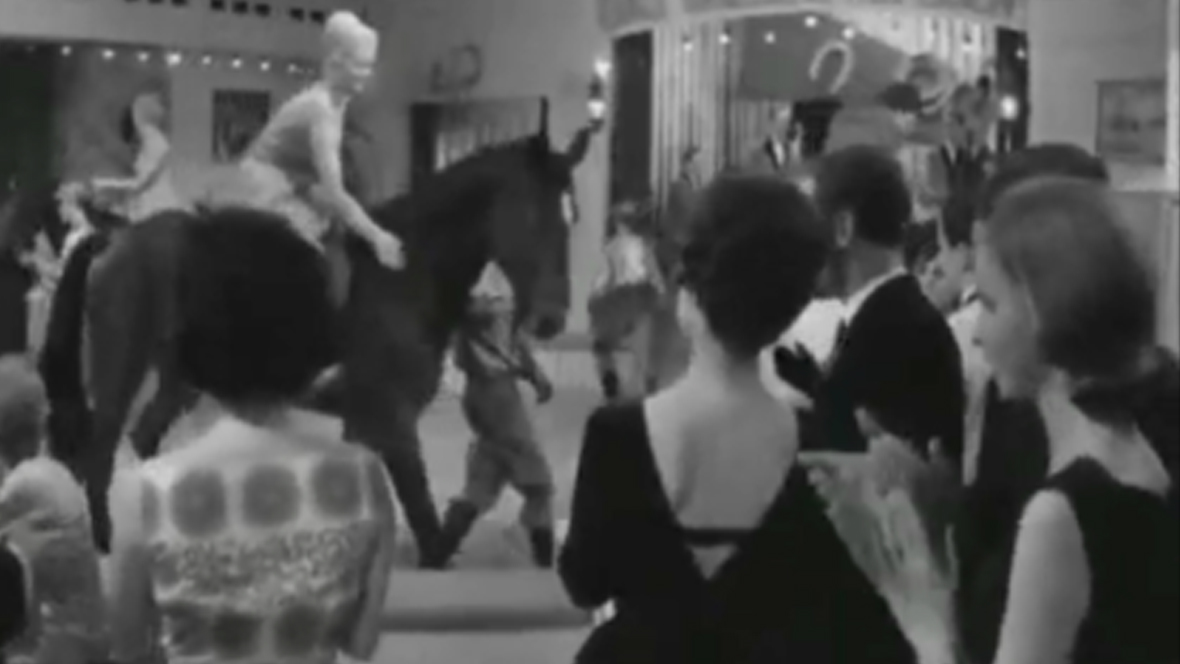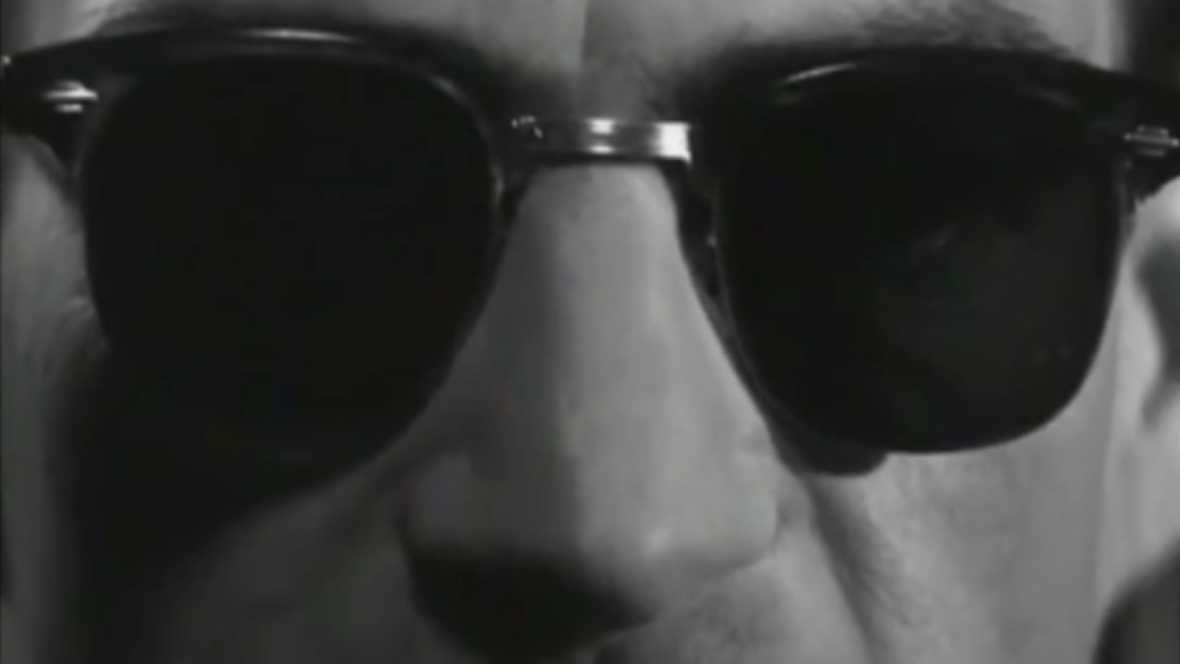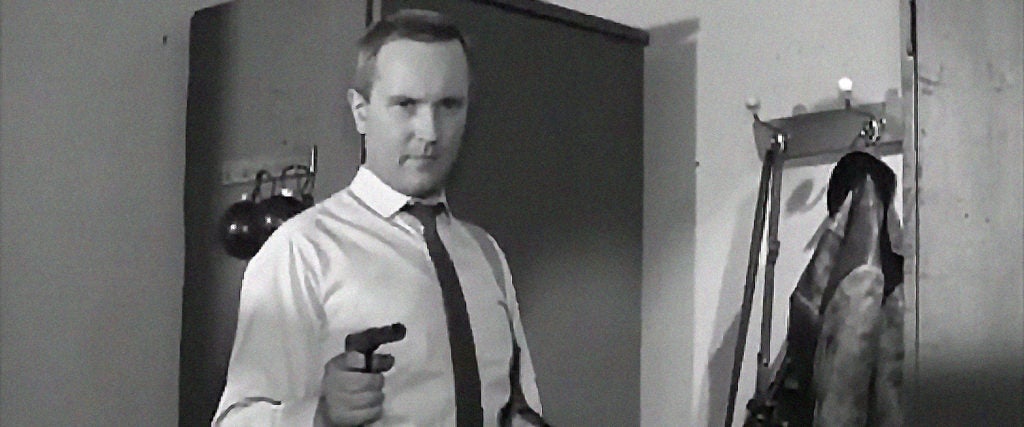Long before David Hasselhoff personally tore down the Berlin Wall with his bare hands in 1989, the East Germans, like much of the rest of the world, loved Western super-spy James Bond. He was handsome! He had gadgets! Men and women alike couldn’t resist the allure of the man appointed to Her Majesty’s Secret Service.
007 was, of course, problematic for the Eastern Bloc — this was, after all, a cinematic secret agent who promoted capitalism and other nefarious Western ideals. But during the Cold War, with spy versus spy mania afoot and an entire era built on mutual surveillance and stealing each other’s secrets, why not pilfer some sweet movie ideas, too?
And that’s exactly what East Germany did.
On August 13, 1961, the GDR (German Democratic Republic) began constructing a barbed wire and concrete “Antifascistischer Schutzwall” (anti-fascist barrier) — soon to be known more simply as the Berlin Wall — between East and West Berlin. The Cold War was, in every respect, at its chilly height. A little over a year later, James Bond’s first big screen adventure, Dr. No, was released in the U.K., quickly becoming an international sensation, pitting the heroic Capitalist West against the godless dirty commies of the Soviet Union.
Not to be upstaged by the West, DEFA — the state-owned film company of the GDR — created their very own spy genre, known as kundschafterfilm, or “reconnaissance” films. From behind the Iron Curtain, this communist cinematic spy genre is like a journey to a parallel universe, where the Stasi (East Germany’s notorious secret police) are the goodies and Americans are the evil schweinhund villains. Patient Zero of the genre is the 1963 film For Eyes Only (a title which would have been familiar to Bond fans, as Ian Fleming’s 1960 James Bond story anthology was named For Your Eyes Only, the title of which was also used for a later, Roger Moore-starring entry in the Bond film franchise).
Up until this point, it had been taboo to directly refer to the activities of Stasi spies, who were euphemistically referred to in other GDR media as “scouts,” “scouts for peace” or even “simple workers” who were only interested in protecting socialist achievements. But now, the Eastern Bloc needed its own popular hero. It found one in Horst Hesse.
“The idea for the film, For Eyes Only, goes back to the agent Horst Hesse,” says Phillip Zengel, of the DEFA Foundation. Hesse, a real-life spy who’d infiltrated the Military Intelligence Division of the U.S. Army, was touted as the James Bond of East Germany (not too outlandish of an idea, since Fleming based his inspiration for James Bond on a real-life spy himself). This fictionalized version of Hesse’s double-agent exploits proved to be a hit with communist film goers. “It’s estimated that 1.6 million people saw For Eyes Only in GDR cinemas,” says Zengel. “The film was the second most successful DEFA film in 1963.”
But while James Bond films were largely meant as pure escapist entertainment (albeit flaunting capitalism with their luxury cars, bikini-clad femme fatales and expensive gadgets), in East Germany, spy films had to conform to a very particular political stance. The genre was largely seen as a critical reflection on the logic of the Cold War, and aimed to convey a very non-subtle message of superiority over Western capitalism while touting supreme socialist values.
“DEFA was economically [and in terms of content] under the control of the Socialist Party,” says Sven Behrend of the Stasimuseum in Berlin. “The state security had to ensure that all the decisions of the party were consistently implemented and that enemies of the party were disciplined or even eliminated.” The criteria for DEFA films: They had to make a judgement and educate the socialist filmgoer, and the content had to be directed against nihilism, decadence, petty-bourgeois values and abstract art. “The standard for film production corresponded to the human image of the party,” Behrend continues.
The films also had to feature a protagonist who was a “hero of our time.” Thus, no outsiders, uncomfortable contemporaries or troublemakers were allowed on screen, unless the film made a negative judgment about them. Directors who didn’t follow these strict guidelines had their work permits virtually destroyed, were blacklisted or, worse, sometimes imprisoned. “GDR was a socialist party dictatorship,” explains Behrend. “The SED (Socialist Unity Party) had a monopoly of leadership… and a monopoly on opinion.”
The Ministry of Culture oversaw film production and implemented control on every aspect of it — from set design to the casting of actors and screenings. This ethos was the backbone of the world that fueled the East German spy genre, and it can be seen throughout other films from the period: In DEFA’s Hollywood-style Westerns, for example, the Native Americans were portrayed as the good guys while the U.S. Army were the baddies. Shot in various locations around Eastern Europe, the plight of Native Americans was presented as a tragic example of anti-imperialist and anti-capitalist struggle (in fairness, a more accurate view of the Old West than any John Wayne picture ever achieved, although the East German actors playing Native Americans in wigs and brown face remain too jarring to ignore).
Watching For Eyes Only — even without subtitles — is a thoroughly entertaining view of espionage through the Cold War looking glass. Shot in glorious black and white and directed by Hungarian-born János Veiczi, the film harkens back to a snappier time when, as with Bond, spies wore smart suits and ties. But the first thing that throws you is the title sequence. No raunchy female silhouettes here: Instead, stark black and white graphics and a theme song that sounds like something out of The Benny Hill Show.
Still, the film delivers Bond-like gadgets, such as a lighter that turns into a secret hidden camera, while an evil agent from the West smuggles microfilm inside his glass eye. The Western spy adversaries are almost always seen in extreme close-up — with their evil capitalistic eyes and mustaches — some wearing sunglasses to denote that they’re up to no good. The decadent Americans in For Eyes Only listen to crazy jazz music and dance the depraved Twist while sipping highballs inside a swanky bar, where loose women, clad in slinky gowns, ride horses (inside the bar — that’s how decadent it is!).


Propaganda-wise, the film’s job is to lay out the justifications for building the Berlin Wall. The plot — again, loosely based on real-life incidents — follows a Stasi double agent who infiltrates West German intelligence to expose a NATO plot to invade the GDR. By making America’s plans (which are hidden away in a safe) public, the invasion scheme is thwarted.
The film’s Stasi double-agent hero, Hansen, is an exemplary East German: A loyal family man, calm and level-headed. No shaken-but-not-stirred martinis for him — this spy doesn’t drink alcohol. These cinematic Stasi agents live the clean, meritorious lifestyles of a good socialist, unlike the brash agents from the West, who drive fast cars while drinking bottles of champagne and humming the “Battle Hymn of the Republic” that continuously blasts from their car radios.
In reality, the Ministerium für Staatsicherheit (the Stasi) was the most hated and feared institution in all of East Germany, as notably portrayed in the Oscar-winning film, The Lives of Others. The Stasi were known for wiretapping, blackmail and other draconian surveillance techniques. Their actions ranged from sneaking into people’s homes and rearranging their furniture just to fuck with their minds, to forcing citizens to be informants and spy on their neighbors (by the 1970s they had, at least, largely given up on physical torture as a tactic, deeming it to be too crude). To put it into perspective, Vladimir Putin was a member of the Stasi secret police — that’s where he learned his most vile tricks.
“The Stasi has always taken care that its actual methods weren’t shown in the films,” says Behrend. “The aim of state security was to get the GDR population to cooperate with the Stasi. For this reason, the Stasi employees were portrayed as morally good and honorable. The agents of the other side were often former SS soldiers or Gestapo agents and morally depraved.”
Within the GDR, the Stasi sought to infiltrate every institution of society and daily life, and the DEFA films can be seen as a form of ideological socialist brainwashing. “Many people recognized the difference between film and reality,” says Behrend, stating that behind closed doors, East Germans would often react to these films with a mixture of anger, amusement, sarcasm or just plain cynicism.
For Eyes Only laid the foundation for East Germany’s most popular James Bond-ish franchise: Das Unsichtbare Visier (The Invisible Visor), which initially starred Armin Mueller-Stahl. (You might know him from his later work as the oppressive dad in the movie Shine, the head of a crime family in Eastern Promises and the Prime Minister of Israel in The West Wing. He is also the only DEFA actor to go on to have a major Hollywood career because, in pure irony, he ended up defecting to the West.)
Produced by DEFA, Das Unsichtbare Visier is a 16-part television series that ran on East German television from 1973 to 1979. Meuller-Stahl plays Bredebusch, Werner Bredebusch (see what I did there). He is a handsome spy, has uncanny fighting skills, sexy women adore him, and most importantly, he is a Stasi agent loyal to the State.
The show’s opening credits, via Google Translate, read: “This man is Werner Bredebusch. He works on behalf of our Ministry of State Security. He is a scout for peace. His assignment to follow the trail of incriminated Nazis brought him to the center of the secret revitalization of the Federal Republic.”
Set in the 1950s (though people sometimes appear in 1970s fashion), the show follows Bredebusch — who disguises himself as a former fighter pilot — as he infiltrates the military circles in West Germany to expose rampant immorality. Naturally, his Stasi spy colleague works by day at an ad agency, snapping photos of sexy women.
The series was conceived as a “political adventure film with a factual reference,” thus the plots were partially based on such enemy actions as the CIA’s chemical research or apartheid activities in South Africa. Truth and fiction were cleverly mixed so the viewer couldn’t distinguish between real and fictional events, prompting an anti-American worldview to emerge. As with earlier works, the State Security wanted to convey that its work takes place in secret and is always successful, while the West is always portrayed as corrupt and undemocratic.
According to the Stasimuseum archives, Colonel Günter Halle, scriptwriter for Das Unsichtbare Visier, was quoted as saying: “Our scouts are heroes. In the sense of our Marxist-Leninist conception of history and worldview, a hero can only be a hero who fights consistently and using his entire personality against the anachronic, the old, the dying, for its overcoming and annihilation, and who, as a patriot and proletarian internationalist, helps historical progress to breakthrough and victory.”
The political system of the West depicted in Das Unsichtbare Visier has parallels to depictions that were common in pre-1945 German National Socialism. “‘Real power’ in the West is in the hands of a conspiracy that operates underground,” says Behrend of the world presented in such media. “With the Nazis, these were the Jews. In the GDR, they were called ‘cosmopolitans’ or ‘homeless, fatherless capitalists,’ which is roughly the same.”
What all that boils down to is simply: Americans are bad guys. The CIA is portrayed as an evil, scheming organization (which, fair) who sometimes gallivant around in full ninja-style bodysuits as hedonistic West German women dance in gold bikinis. Watching Das Unsichtbare Visier creates a sensation similar to flipping channels between CNN and our own state-run TV, Fox News.
“From the beginning of the State Security, this series has been seen as … an opportunity to polish up one’s own image,” says historian Christoph Classen in an interview with MDR Zeitreise. “It was an attempt to present the socialist message in an attractive packaging that was very much inspired by Western models.” Naturally, the state-run production company hoped the series would improve the Stasi’s reputation among the East German population. “Television was part of agitation and propaganda with the help of ideology,” explains Behrend. “The SED desperately needed economic success and propagandistic support for its struggle.”
As a result, the GDR spy thriller is unabashed about stealing the classic Bond tropes. The uncanny similarities were intentional, and for good reason. “A vast majority of East German viewers were able to receive both East German and West German television,” says Henning Wrage, professor of German media studies at Gettysburg College. This meant that even though the Cold War was on, James Bond films could still be seen on East German TV screens. “Always with significant delays,” adds Wrage, who grew up in the GDR.
In the opening credits, Bredebusch, like Bond, is viewed down the barrel of a gun, backed by a musical score that sounds like an East German imitation of the Goldfinger theme. “Productions such as Das Unsichtbare Visier are recognizably similar to the original,” says Wrage. “When it comes to the comparison with Bond, absolutely, the music is clearly ‘inspired’ by the James Bond soundtrack.”
Wrage and colleague Thomas Beutelschmidt coined a specific term for this kind of interrelation between East and West culture: Contrastive dialogue. The idea was, “to give a name to the almost impossible challenge for East German TV to have to be entertaining if it wanted to be competitive enough to convey political content as well,” Wrage explains. Wrage’s theory is comparable to Christian rock — music that attempts to sound like popular, mainstream music to reel in the kids, all the while trying to slip through its Jesus message.
There were, necessarily, differences, too. Unlike James Bond, the show’s secret agent protagonist is also a friend of the working class. He can be seen adorned in casualwear, sharing drinks down at the local pub. You wouldn’t see that from James Bond, especially in the tuxedo-clad Roger Moore era. But still, the blatant James Bond parallels worked: Das Unsichtbare Visier was hugely popular in East Germany. In the GDR, one quarter of its 16 episodes were watched by roughly half of all TV viewers. Walter Kubiczeck’s soundtrack was so popular it was released in GDR on two LPs (in fairness, it’s pretty funky).
Eventually though, the final fate of Das Unsichtbare Visier was the same as that of the Iron Curtain itself. Mueller-Stahl left the series in 1976, blacklisted by the state for his protest of the expatriation of popular East German singer Wolf Biermann. Thus, Mueller-Stahl was replaced in the lead role by actor Horst Schulze.
The departure marked a dip in the show’s popularity, but the writing was already on the wall, not only for Das Unsichtbare Visier, but also for the GDR. Mueller-Stahl fled the country in 1980 and, as already mentioned, went on to establish a prominent career in the West. Ronald Reagan became president in 1981 and the Cold War began to ease: Das Unsichtbare Visier, the series that existed solely to criticize the Western political system, was beginning to feel outdated, and a spin-off series promptly tanked. When the Berlin Wall came down in 1989, it was the nail in the coffin for kundschafterfilm.
“DEFA was finally dissolved in 1992,” says Zengel. “Many filmmakers became unemployed; most of them were unable to make any more films. Others — especially younger people — found their way better in the new economic system and continued working in the film industry.”
DEFA’s films, which despite their origins had their charms, became a piece of cinematic history. (1974’s Jacob the Liar was the only GDR film ever nominated for an Academy Award. It also featured Mueller-Stahl, and has the accolade of being the only DEFA film remade in the West — though it starred Robin Willams and flopped.) Episodes of Das Unsichtbare Visier can be found on YouTube, but the series has never been dubbed or released with subtitles, thus remaining an obscurity to English-speaking Bond fans.
In Deutschland, however, it’s a different story. “The show has become cult amongst some younger German audiences for their outrageousness,” Wrage tells me. “In a way, it compares pretty well to the early Bond movies.”
Ultimately, Das Unsichtbare Visier is a series that had once shaken East Germany — but it failed to stir the West.

